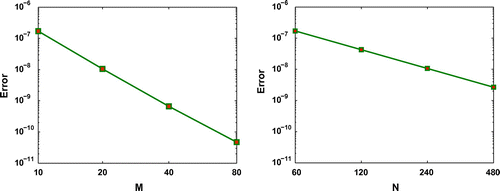 ?Mathematical formulae have been encoded as MathML and are displayed in this HTML version using MathJax in order to improve their display. Uncheck the box to turn MathJax off. This feature requires Javascript. Click on a formula to zoom.
?Mathematical formulae have been encoded as MathML and are displayed in this HTML version using MathJax in order to improve their display. Uncheck the box to turn MathJax off. This feature requires Javascript. Click on a formula to zoom.Abstract
The problem of finding the solution of partial differential equation with source control parameter has appeared increasingly in physical phenomena, for example, in the study of heat conduction process, chemical diffusion and control theory. In this paper, we use a high-order scheme for determining unknown control parameter and unknown solution of parabolic inverse problem. In the proposed numerical scheme, we replace the space derivative with a fourth-order compact finite difference approximation. We will investigate the stability and convergence of proposed scheme and show that the convergence order is . Also due to the usually ill-posed nature of inverse problems, we examine the stability of method with respect to perturbations of the data. Numerical results corroborate the theoretical results and high accuracy of proposed scheme in comparison with the other methods in the literature.
1 Introduction
The parameter determination in a parabolic partial differential equation from the over-specified data plays a crucial role in applied mathematics and physics. This technique has been widely used to determine the unknown properties of a region by measuring only data on its boundary or a specified location in the domain. These unknown properties, such as conductivity, are important to the physical process but usually cannot be measured directly, or very expensive to be measured. The literature on the numerical approximation of solutions of parabolic partial differential equations with standard boundary conditions is large and still growing rapidly.[Citation1] While many finite difference, finite element, spectral, finite volume and boundary element methods have been proposed to approximate such solutions, there has been less research into the numerical approximation of parabolic partial differential equations with over-specified boundary data. Over the last few years, it has become increasingly apparent that many physical phenomena can be described in terms of parabolic partial differential equations with source control parameters.[Citation2–Citation7] The main contribution of this paper is to propose a high-order method to approximate the solution of the following inverse problem, i.e. to find the unknown control parameter in the semi-linear time-dependent diffusion equation
1.1
1.1 with initial condition
1.2
1.2 and boundary conditions
1.3
1.3 subject to the over-specification at a point in the spatial domain
1.4
1.4 where
and
are known functions which are positive and continuous,
and
are at least once and twice differentiable, respectively,
,
and
are unknown functions. The existence and uniqueness and continuous dependence of the solutions to some kind of these inverse problems are discussed in [Citation6, Citation8–Citation12]. The applications of these inverse problems and some other similar parameter identification problems are discussed in [Citation13, Citation14]. The inverse problem (Equation1.1
1.1
1.1 )–(Equation1.4
1.4
1.4 ) can be used to describe a heat transfer process with a source parameter
, where for example (Equation1.4
1.4
1.4 ) represents the temperature at a given point
in a spatial domain at a time
, and
is the temperature distribution.
Cannon et al. [Citation7] formulated a backward Euler finite difference scheme via a transformation and proved the convergence of u with the convergence order of . Dehghan in [Citation15–Citation17] presented four difference schemes for the problems (Equation1.1
1.1
1.1 )–(Equation1.4
1.4
1.4 ). They are three-point explicit, five-point explicit, three-point implicit and implicit Crandalls schemes. Also a numerical scheme based on the method of radial basis function for problem (Equation1.1
1.1
1.1 )–(Equation1.4
1.4
1.4 ) is proposed in [Citation18]. Dehghan and Saadatmandi in [Citation19] proposed a tau method for the solution of problem (Equation1.1
1.1
1.1 )–(Equation1.4
1.4
1.4 ). A method of line approach based on the applying standard finite difference schemes and Runge-Kutta method presented in [Citation20] for (Equation1.1
1.1
1.1 )–(Equation1.4
1.4
1.4 ). Also the approximation of moving least-square (MLS) has been used in [Citation21] for finding the solution of problems (Equation1.1
1.1
1.1 )–(Equation1.4
1.4
1.4 ). A coefficient inverse problem of the one-dimensional parabolic equation is solved by a high-order compact finite difference method in [Citation22]. Liao in [Citation23] combined an efficient high-order finite difference method for solving wave equation, auto differentiation tools and globally convergent optimization algorithms to estimate the unknown coefficient in a 1-D wave equation. Another effective method based on Ritz-Galerkin method for solving an inverse heat conduction problem with a nonlinear source term via Bernstein multi-scaling functions and cubic B-spline functions is proposed in [Citation24]. The authors of [Citation25, Citation26] suggested some numerical approximations which do not use any transformation to solve inverse problem (Equation1.1
1.1
1.1 )–(Equation1.4
1.4
1.4 ). An approach for the inverse problem for a fractional parabolic equation is given in [Citation27] and some discussions about inverse problem for elliptic equations are proposed in [Citation28, Citation29]. Finite difference scheme for the estimation of heat source dependent on time variable is given in [Citation30]. Finite volume method is used in [Citation31] to solve a one-dimensional parabolic inverse problem with source term and Neumann boundary conditions. The inverse problem of finding the time-dependent coefficient of heat capacity together with the nonlocal boundary conditions is considered in [Citation32]. Under some natural regularity and consistency conditions on the input data, the existence, uniqueness and continuous dependence upon the data of the solution are shown. A new method by the reproducing kernel Hilbert space in [Citation33] is applied to generalized form of the inverse heat problem (Equation1.1
1.1
1.1 )–(Equation1.4
1.4
1.4 ). The problem is reduced to a system of linear equations. The exact and approximate solutions are both obtained in a reproducing kernel space. By the Green’s function method, the inverse problem (Equation1.1
1.1
1.1 )–(Equation1.4
1.4
1.4 ) is reduced to an operator equation of the first kind in [Citation34]. The uniqueness of the solution for the inverse problem is obtained by the contraction mapping principle. A second order of accuracy implicit difference scheme is presented in [Citation35] for a right-hand side identification problem. The coercive stability estimates for the solution of this difference scheme are obtained. A numerical method based on the method of lines for the solution of inverse problem (Equation1.1
1.1
1.1 )–(Equation1.4
1.4
1.4 ) is given in [Citation36]. The radial basis functions (RBFs) method is employed in [Citation37] to handle a class of multi-dimensional parabolic inverse problems. Based on the idea of RBF approximation, a fast and highly accurate meshless method is developed for solving an inverse problem with a control parameter. A method based on combination of compact finite difference scheme with boundary value methods is proposed in [Citation38]. Authors of [Citation39] proposed a numerical method of order
for Equations (Equation1.1
1.1
1.1 )–(Equation1.4
1.4
1.4 ) and proved the solvability, stability and convergence of it. Also a linearized compact scheme of order
is given in [Citation40] with only solvability analysis. Some other numerical schemes are given in [Citation41–Citation45].
Some of the above finite difference methods in the literature have low order of accuracy [Citation15–Citation17, Citation30, Citation39] or be high-order schemes without any discussion about stability and convergence analysis.[Citation20, Citation24, Citation38, Citation40] In this paper, we propose an efficient algorithm for solving problem (Equation1.11.1
1.1 )–(Equation1.4
1.4
1.4 ) which is of order
. We analyse the stability and convergence of proposed method. We will compare the results of applied method with the results of other schemes in the literature to show the high accuracy and efficiency of proposed method. Also it is well-known that inverse heat conduction problems are highly ill-posed, that is, a small change in the input data can result in an enormous change in the computed solution. Thus, the stability of the numerical method with respect to the noise in the data is of vital importance for obtaining physically meaningful results. On the other hand, since
is measured, there will be a measurement error in it. We will investigate the effect of this error on the approximate solutions.
The outline of this paper is as follows: In Section 2, we introduce the derivation of compact scheme for the solution of Equation (Equation1.11.1
1.1 ). In Section 3, we investigate the stability and convergence of applied method. The numerical results obtained from applying the new method on two test problems and comparison with analytical and other methods, are shown in Section 4. We conclude this article with a brief conclusive discussion in Section 5.
2 Derivation of proposed scheme
For positive integer numbers and
, let
denotes the step size of spatial variable
and
denotes the step size of time variable,
, where
and
is the final time. So we define
Without the loss of generality, we can choose the mesh such that for some
,
, we have
. The exact and approximate solutions at the point
are denoted by
and
, respectively.
We first use the following transformation [Citation16, Citation38]2.1
2.1 Then the problem (Equation1.1
1.1
1.1 )–(Equation1.4
1.4
1.4 ) can be written as follows:
2.2
2.2
2.3
2.3
2.4
2.4 It follow from (Equation2.1
2.1
2.1 ) and (Equation1.4
1.4
1.4 ) that
or,
2.5
2.5 Substituting (Equation2.5
2.5
2.5 ) into (Equation2.2
2.2
2.2 )–(Equation2.4
2.4
2.4 ) gives
2.6
2.6 where
Now we define the following mesh functions
Also we introduce the following notations [Citation39, Citation40]
Let [Citation40]
2.7
2.7 Then it follows from (Equation2.6
2.6
2.6 ) that
2.8
2.8 Considering Equation (Equation2.8
2.8
2.8 ) at the point
we have
2.9
2.9 i.e.
2.10
2.10 Using fourth-order finite difference scheme for the second-order spatial derivative,[Citation38, Citation46] we obtain
2.11
2.11 Substituting (Equation2.10
2.10
2.10 ) into (Equation2.11
2.11
2.11 ), we get
2.12
2.12
2.13
2.13
2.14
2.14 If we use the Taylor expansion, we obtain [Citation40]
2.15
2.15
2.16
2.16
2.17
2.17 where there is a constant
such that
2.18
2.18 Again using the Taylor expansion, we have
2.19
2.19 and there is a constant
such that
2.20
2.20 Eliminating small terms in (Equation2.15
2.15
2.15 ) and (Equation2.19
2.19
2.19 ), we obtain
2.21
2.21 or
and
2.22
2.22
2.23
2.23
2.24
2.24 For obtaining
, it follows from (Equation2.1
2.1
2.1 ) and (Equation2.5
2.5
2.5 ) that
or,
2.25
2.25 From (Equation1.1
1.1
1.1 ) and (Equation1.4
1.4
1.4 ) we have
2.26
2.26 where
. Using the following fourth-order difference scheme
we can write
2.27
2.27 and there is a constant
such that
2.28
2.28 Omitting the small term in (Equation2.27
2.27
2.27 ), for
we have
2.29
2.29 Note that for
we can write
2.30
2.30 So the final fourth-order difference scheme for the solution of (Equation1.1
1.1
1.1 )–(Equation1.4
1.4
1.4 ) is as follows:
2.31
2.31
2.32
2.32
2.33
2.33
2.34
2.34
2.35
2.35
2.36
2.36
2.37
2.37
3 Analysis of method
In this section, we analyse the stability and convergence of proposed method. Firstly we assume [Citation39]which will be used in the proof of Lemma 1.
Lemma 1
Let be the solution of difference scheme
3.1
3.1 with initial and boundary conditions
3.2
3.2
3.3
3.3 then for
we have
where
depends on
and
and
Proof
It follows from (Equation3.13.1
3.1 ) that
If
, we have
From (Equation3.3
3.3
3.3 ) we can rewrite above equation as follows:
Therefore,
3.4
3.4 If
, we have
So
3.5
3.5 If
, we have
Using (Equation3.3
3.3
3.3 ) we can write
thus, we can state
3.6
3.6 Considering (Equation3.4
3.4
3.4 )–(Equation3.6
3.6
3.6 ), we have
According to relation (Equation3.3
3.3
3.3 ) we can write
So we have
Now if
, we have
Changing index from
to
in above relation gives
3.7
3.7 Summing up (Equation3.7
3.7
3.7 ) from
to
results
According to
there is a positive constant
such that
Consequently,
The discrete Gronwall lemma [Citation47] gives us
which completes the proof.
Theorem 1
Let be the solution of compact finite difference scheme (Equation2.31
2.31
2.31 )–(Equation2.34
2.34
2.34 ), then this difference scheme is stable under the assumptions of Lemma 1.
Proof
From Lemma 1 and regarding to in (Equation2.31
2.31
2.31 ), we can state that
which shows the stability of the proposed difference scheme.
Now we prove that the difference scheme (Equation2.312.31
2.31 )–(Equation2.34
2.34
2.34 ) converges with the spatial accuracy of fourth order.
Theorem 2
Let and
be the solutions of (Equation2.15
2.15
2.15 )–(Equation2.17
2.17
2.17 ) and (Equation2.31
2.31
2.31 )–(Equation2.34
2.34
2.34 ), respectively, then under the assumptions of Lemma 1, the difference scheme (Equation2.31
2.31
2.31 )–(Equation2.35
2.35
2.35 ) converges with the convergence order
.
Proof
We define the following notationSubtracting (Equation2.31
2.31
2.31 )–(Equation2.35
2.35
2.35 ) from (Equation2.15
2.15
2.15 )–(Equation2.17
2.17
2.17 ), we obtain
3.8
3.8
3.9
3.9
3.10
3.10 According to above relations, we can set
, so from Lemma 1 and Equation (Equation2.18
2.18
2.18 ), we have
which completes the proof.
4 Numerical results
In this section, we present the numerical results of the new method on two test problems. We tested the accuracy and stability of the method for different values of and
. We performed our computations using Matlab 7 software on a Pentium IV, 2800 MHz CPU machine with 2 Gbyte of memory. To illustrate the accuracy of the method and to compare with other methods in the literature, we compute the following error norms:
4.1
4.1 Also we investigate a measurement error in
for both test problems. Let
, then we will replace exact value of
by noisy data given as follows
4.2
4.2 The function ‘ randn(.)’ generates arrays of random numbers whose elements are normally distributed and it is realized using the MATLAB function randn.
4.1 Test problem 1
Consider the parabolic problem with control parameter [Citation15]The exact solution is given as follows:
Test problem 1 is a direct problem, used to test the proposed compact scheme formulation against mentioned analytic solution. We solve this problem with the method presented in this article with several values of
and
at final time
. In Tables and , we compare the absolute error of some technique for the solution of this test problem and report the CPU time of proposed method in Tables and . As we see the results of present method are better from the results of [Citation15, Citation40]. It is compatible with theoretical results, since method of [Citation15] is of order
and although the method of [Citation40] is of order
, but it is a linearized compact difference scheme.
Table 1. Comparison of absolute error in for several methods.
Table 2. Comparison of absolute error in for several methods.
Table 3. Comparison of absolute error in for several methods.
Also Tables and show the absolute error obtain in approximating and
for some methods in the literature. Again we see that the results of the present method are very satisfactory. Figure presents the absolute errors for both unknown function and unknown control parameter. We show the noise in
and resulting error in approximate solution with
,
and
in Figure and
in Figure . As we see, the proposed method produces satisfactory results and is stable respect to noise in the
.
Table 4. Comparison of absolute error in for several methods.
Figure 1. Errors obtained in approximating (left panel) and
(right panel) with
and
for Test Problem 1.
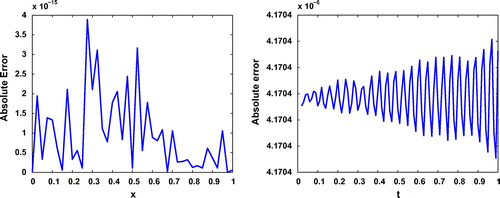
Figure 2. A noise () in
(left panel) and resulting absolute error in approximating
(
,1) (right panel) for Test problem 1 with
,
and
.
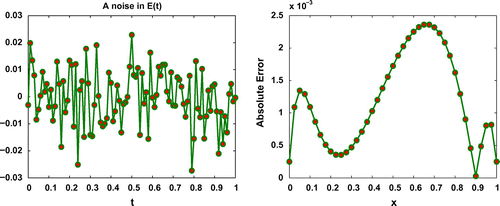
Figure 3. A noise () in
(left panel) and resulting absolute error in approximating
(
,1) (right panel) for Test problem 1 with
,
and
.
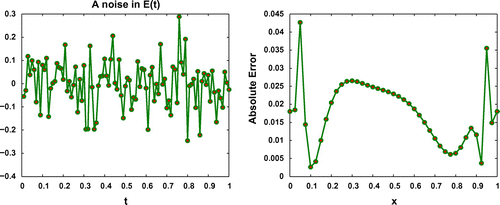
In Table we present the resulting error at different times for some positions with and
for Test problem 1.
4.2 Test problem 2
Consider the problem (Equation1.11.1
1.1 )–(Equation1.4
1.4
1.4 ) with
,
,
The exact solutions are given as follows:
This test problem is a direct inverse problem, used to test the proposed compact scheme formulation against mentioned analytic solution. Table presents the numerical and the exact solutions of
at some points. Also Table gives the numerical and the exact solutions of
at some points.
Table 5. Errors at different times for some positions with and
.
Table 6. Numerical results and exact solutions of at some points.
Table 7. Numerical results and exact solutions of at some points.
Table 8. Absolute values of the errors in approximating .
Table 9. Absolute values of the errors in approximating .
Table 10. Errors obtained in approximating and
.
Table 11. Comparison of absolute error in approximating with
.
As we see the numerical solutions are in good agreement with the exact solutions. Tables and show the absolute error obtained in approximating and
for some points.
Table shows the and
errors of the difference scheme, respectively.
Table 12. Comparison of absolute error in approximating with
.
In Tables and , we compare the numerical results of the proposed method with MOL method [Citation20] when and
. As we see the present method has better results. Figure presents the errors obtained in approximating
(left panel) and
(right panel) with
and
.
Table 13. Errors, computational orders and CPU time in Test problem 2 for .
Table 14. Errors at different times for some positions with and
.
Figure 6. A noise () in
(left panel) and resulting absolute error in approximating
(
,1) (right panel) for Test problem 2 with
,
and
.

To investigate the order of method numerically, in Figure we plot the error versus with
fixed and vice versa, where the log-log scaling is used for the axes. The slope of the error curves show the order of accuracy of proposed method. To more clarify the results, we calculate the computational orders (denoted by C-Order) with the following formula
in which
and
are errors correspond to grids with mesh size
and
, respectively. Table presents the computational orders and CPU time in Test problem 2 for
.
Table shows the fourth and second order of accuracy of method in space and time components, respectively. In Table , we present the resulting error at different times for some positions with and
for Test problem 2.
Figure 7. A noise () in
(left panel) and resulting absolute error in approximating
(
,1) (right panel) for Test problem 2 with
,
and
.
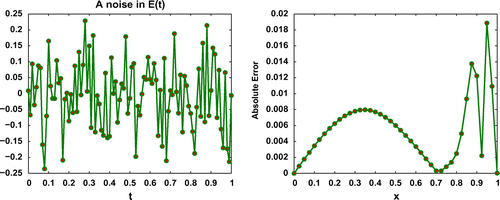
We show the noise in and resulting error in approximate solution with
,
and
in Figure and
in Figure for Test problem 2. As we see, the proposed method produces satisfactory results and is stable respect to noise in the
.
5 Conclusion
In this paper we introduced a high order scheme for determining unknown control parameter and unknown solution of parabolic inverse problem with overspecification at a point in the spatial domain. In the proposed numerical scheme we replaced the space derivative with a fourth-order compact finite difference. We proved the stability and convergence of proposed scheme and showed that the convergence order is . Numerical results corroborate the theoretical results and high accuracy of proposed scheme in comparison with the other methods in the literature. Also we investigated the effect of noise on the data and obtained satisfactory results with new method.
Acknowledgements
The authors would like to thank the five referees and the associate editor for the careful reading of the paper and the thoughtful comments and suggestions, which have considerably improved the quality of the paper.
Notes
The authors are also thankful to the University of Kashan for the financial support [grant number 364989/1] of this work.
References
- Mohebbi A, Abbaszadeh M, Dehghan M. A high-order and unconditionally stable scheme for the modified anomalous fractional sub-diffusion equation with a nonlinear source term. J. Comput. Phys. 2013;240:36–48.
- Cannon JR, Lin Y. Determination of parameter p(t) in Holder classes for some semilinear parabolic equations. Inverse Probl. 1988;4:595–606.
- Cannon JR, Lin Y. An inverse problem of finding a parameter in a semilinear heat equation. J. Math. Anal. Appl. 1990;145:470–484.
- Cannon JR, Yin HM. On a class of non-classical parabolic problems. J. Differ. Equ. 1989;65: 54–45.
- Cannon JR, Yin HM. Numerical solutions of some parabolic inverse problems. Numer. Meth. Partial Differ. Equ. 1990;2:177–191.
- Cannon JR, Lin Y, Wang S. Determination of source parameter in parabolic equations. Meccanica. 1992;27:85–94.
- Cannon JR, Lin YL, Xu S. Numerical procedures for the determination of an unknown coefficient in semi-linear parabolic differential equations. Inverse Probl. 1994;10:227–243.
- Deckert KL, Maple CG. Solution for diffusion with integral type boundary conditions. Proc. Iowa Acad. Sci. 1963;70:354–361.
- Lin Y. Analytical and numerical solutions for a class of nonlocal nonlinear parabolic differential equations. Siam. J. Math. Anal. 1994;25:1577–1594.
- Macbain JA, Bendar JB. Existence and uniqueness properties for one-dimensional magnetotelluric inversion problem. J. Math. Phys. 1986;27:645–649.
- Prilepko AI, Soloev VV. Solvability of the inverse boundary value problem of finding a coefficient of a lower order term in a parabolic equation. Differ. Equ. 1987;23:136–143.
- Rundell W. Determination of an unknown non-homogenous term in a linear partial differential equation from overspecified boundary data. Appl. Anal. 1980;10:231–242.
- Ionkin NI. Solution of a boundary value problem in heat conduction with a nonclassical boundary condition. Differ. Equ. 1977;13:204–211.
- Macbain JA. Inversion theory for a parametrized diffusion problem. SIAM J. Appl. Math. 1987;18:1386–1391.
- Dehghan M. Finding a control parameter in one-dimensional parabolic equations. Appl. Math. Comput. 2003;135:491–503.
- Dehghan M. Parameter determination in a partial differential equation from the overspecified data. Math. Compu. Model. 2005;41:197–213.
- Dehghan M. An inverse problem of finding a source parameter in a semilinear parabolic equation. Appl. Math. Modell. 2002;25:743–754.
- Dehghan M, Tatari M. Determination of a control parameter in a one-dimensional parabolic equation using the method of radial basis functions. Math. Comput. Model. 2006;44:1160–1168.
- Dehghan M, Saadatmandi A. A tau method for the one-dimensional parabolic inverse problem subject to temperature overspecification. Comput. Math. Appl. 2006;52:933–940.
- Dehghan M, Shakeri F. Method of lines solutions of the parabolic inverse problem with an overspecification at a point. Numer. Algor. 2009;50:417–437.
- Cheng R. Determination of a control parameter in a one-dimensional parabolic equation using the moving least-square approximation. Int. J. Compu. Math. 2008;85:1363–1373.
- Liao W, Dehghan M, Mohebbi A. Direct numerical method for an inverse problem of a parabolic partial differential equation. J. Comput. Appl. Math. 2009;232:351–360.
- Liao W. A computational method to estimate the unknown coefficient in a wave equation using boundary measurements. Inverse Probl. Sci. Eng. 2011;19:855–877.
- Dehghan M, Yousefi SA, Rashedia K. Ritz-Galerkin method for solving an inverse heat conduction problem with a nonlinear source term via Bernstein multi-scaling functions and cubic B-spline functions. Inverse Probl. Sci. Eng. 2013;21:500–523.
- Ashyralyev A, Erdogan AS, Demirci E. Numerical solution of a one-dimensional parabolic inverse problem. In Further progress in analysis: Proceedings of the 6th International ISAAC Congress, Aug. 2007. Ankara/Turkey: World Scientific; 2007. p. 654–663.
- Ashyralyev A, Erdogan AS. On the numerical solution of a parabolic inverse problem with the Dirichlet condition. Int. J. Math. Comput. 2011;11:73–81.
- Erdogan AS, Uygun H. A note on the inverse problem for a fractional parabolic equation. Abst. Appl. Anal. 2012. Article ID 276080. 26 p.
- Ashyralyyev C. High order of accuracy difference schemes for the inverse elliptic problem with Dirichlet condition. Bound. Value Probl. 2014;2014:5.
- Ashyralyyev C, Dedeturk M. Approximate solution of inverse problem for elliptic equation with overdetermination. Abst. Appl. Anal. 2013. Article ID 548017. 11 p.
- Ashyralyev A, Erdogan AS. Finite difference method for the estimation of a heat source dependent on time variable. Malaysian J. Math. Sci. 2012;6:139–150.
- Wang B, Zou G, Zhao P, Wang Q. Finite volume method for solving a one-dimensional parabolic inverse problem. Appl. Math. Comput. 2011;217:5227–5235.
- Kanca F, Baglan I. An inverse coefficient problem for a quasilinear parabolic equation with nonlocal boundary conditions. Bound. Value Probl. 2013;2013:213.
- Wang W, Hana B, Yamamoto Ma. Inverse heat problem of determining time-dependent source parameter in reproducing kernel space. Nonlinear Anal. Real World Appl. 2013;14:875–887.
- Kerimova NB, Ismailov MI. An inverse coefficient problem for the heat equation in the case of nonlocal boundary conditions. Math. Comput. Simul. 2011;81:1656–1672.
- Erdogan AS, Ashyralyev A. On the second order implicit difference schemes for a right hand side identification problem. Appl. Math. Comput. 2014;226:212–228.
- Aida-zadea KR, Rahimov AB. An approach to numerical solution of some inverse problems for parabolic equations. Inverse Probl. Sci. Eng. 2014;22:96–111.
- Maa L, Wua Z. Radial basis functions method for parabolic inverse problem. Int. J. Comput. Math. 2011;88:384–395.
- Mohebbi A, Dehghan M. High-order scheme for determination of a control parameter in an inverse problem from the over-specified data. Comput. Phys. Commun. 2010;181:1947–1954.
- Ye CR, Sun ZZ. On the stability and convergence of a difference scheme for an one-dimensional parabolic inverse problem. Appl. Math. Comput. 2007;188:214–225.
- Ye CR, Sun ZZ. A linearized compact difference scheme for an one-dimensional parabolic inverse problem. Appl. Math. Modell. 2009;33:1521–1528.
- Baran EC. Numerical procedures for determining of an unknown parameter in parabolic equation. Appl. Math. Comput. 2005;162:1219–1226.
- Deolmi G, Marcuzzi F. A parabolic inverse convection-diffusion-reaction problem solved using spacetime localization and adaptivity. Appl. Math. Comput. 2013;219:8435–8454.
- Fatullayev A, Can E. Numerical procedures for determining unknown source parameter in parabolic equations. Math. Comput. Simul. 2000;54:159–167.
- Fatullayev AG. Numerical procedure for the determination of an unknown coefficients in parabolic equations. Comput. Phys. Commun. 2002;144:29–33.
- Li F, Wu Z, Ye CR. A finite difference solution to a two-dimensional parabolic inverse problem. Appl. Math. Modell. 2012;36:2303–2313.
- Lele SK. Compact nite difference schemes with spectral-like resolution. J. Comput. Phys. 1992;103:16–42.
- Quarteroni A, Valli A. Numerical approximation of partial differential equations. Berlin: Springer-Verlag; 2008.


